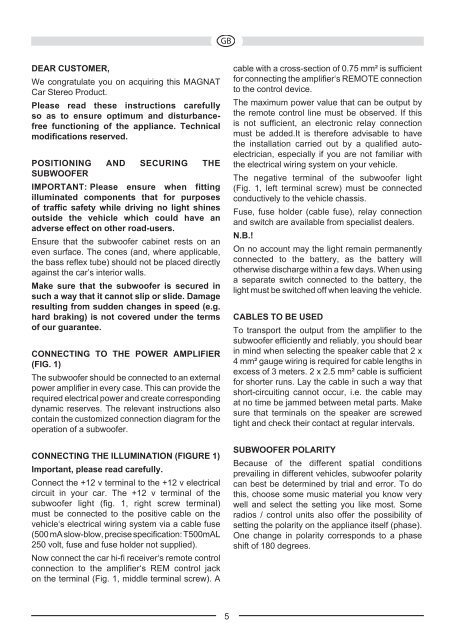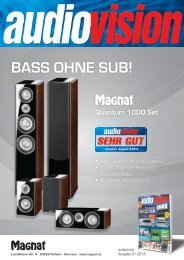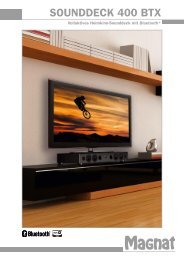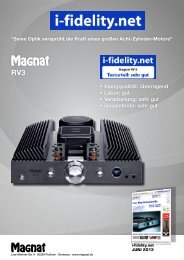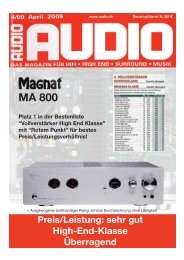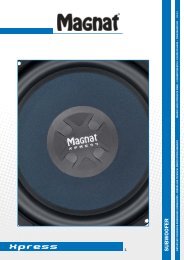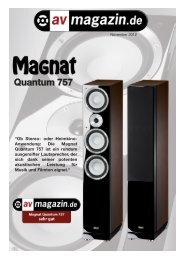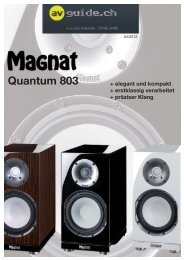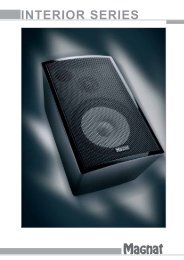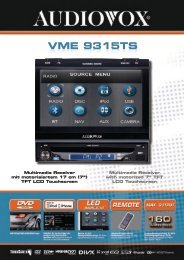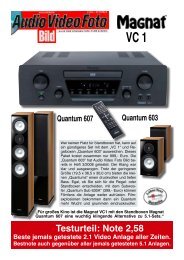Create successful ePaper yourself
Turn your PDF publications into a flip-book with our unique Google optimized e-Paper software.
DEAR CUSTOMER,<br />
We congratulate you on acquiring this MAGNAT<br />
Car Stereo Product.<br />
Please read these instructions carefully<br />
so as to ensure optimum and disturbancefree<br />
functioning of the appliance. Technical<br />
modifications reserved.<br />
POSITIONING AND SECURING THE<br />
SUBWOOFER<br />
IMPORTANT: Please ensure when fitting<br />
illuminated components that for purposes<br />
of traffic safety while driving no light shines<br />
outside the vehicle which could have an<br />
adverse effect on other road-users.<br />
Ensure that the subwoofer cabinet rests on an<br />
even surface. The cones (and, where applicable,<br />
the bass reflex tube) should not be placed directly<br />
against the car’s interior walls.<br />
Make sure that the subwoofer is secured in<br />
such a way that it cannot slip or slide. Damage<br />
resulting from sudden changes in speed (e.g.<br />
hard braking) is not covered under the terms<br />
of our guarantee.<br />
CONNECTING TO THE POWER AMPLIFIER<br />
(FIG. 1)<br />
The subwoofer should be connected to an external<br />
power amplifier in every case. This can provide the<br />
required electrical power and create corresponding<br />
dynamic reserves. The relevant instructions also<br />
contain the customized connection diagram for the<br />
operation of a subwoofer.<br />
CONNECTING THE ILLUMINATION (FIGURE 1)<br />
Important, please read carefully.<br />
Connect the +12 v terminal to the +12 v electrical<br />
circuit in your car. The +12 v terminal of the<br />
subwoofer light (fig. 1, right screw terminal)<br />
must be connected to the positive cable on the<br />
vehicle‘s electrical wiring system via a cable fuse<br />
(500 mA slow-blow, precise specification: T500mAL<br />
250 volt, fuse and fuse holder not supplied).<br />
Now connect the car hi-fi receiver‘s remote control<br />
connection to the amplifier‘s REM control jack<br />
on the terminal (Fig. 1, middle terminal screw). A<br />
cable with a cross-section of 0.75 mm² is sufficient<br />
for connecting the amplifier‘s REMOTE connection<br />
to the control device.<br />
The maximum power value that can be output by<br />
the remote control line must be observed. If this<br />
is not sufficient, an electronic relay connection<br />
must be added.It is therefore advisable to have<br />
the installation carried out by a qualified autoelectrician,<br />
especially if you are not familiar with<br />
the electrical wiring system on your vehicle.<br />
The negative terminal of the subwoofer light<br />
(Fig. 1, left terminal screw) must be connected<br />
conductively to the vehicle chassis.<br />
Fuse, fuse holder (cable fuse), relay connection<br />
and switch are available from specialist dealers.<br />
N.B.!<br />
On no account may the light remain permanently<br />
connected to the battery, as the battery will<br />
otherwise discharge within a few days. When using<br />
a separate switch connected to the battery, the<br />
light must be switched off when leaving the vehicle.<br />
CABLES TO BE USED<br />
To transport the output from the amplifier to the<br />
subwoofer efficiently and reliably, you should bear<br />
in mind when selecting the speaker cable that 2 x<br />
4 mm² gauge wiring is required for cable lengths in<br />
excess of 3 meters. 2 x 2.5 mm² cable is sufficient<br />
for shorter runs. Lay the cable in such a way that<br />
short-circuiting cannot occur, i.e. the cable may<br />
at no time be jammed between metal parts. Make<br />
sure that terminals on the speaker are screwed<br />
tight and check their contact at regular intervals.<br />
SUBWOOFER POLARITY<br />
Because of the different spatial conditions<br />
prevailing in different vehicles, subwoofer polarity<br />
can best be determined by trial and error. To do<br />
this, choose some music material you know very<br />
well and select the setting you like most. Some<br />
radios / control units also offer the possibility of<br />
setting the polarity on the appliance itself (phase).<br />
One change in polarity corresponds to a phase<br />
shift of 180 degrees.<br />
5


